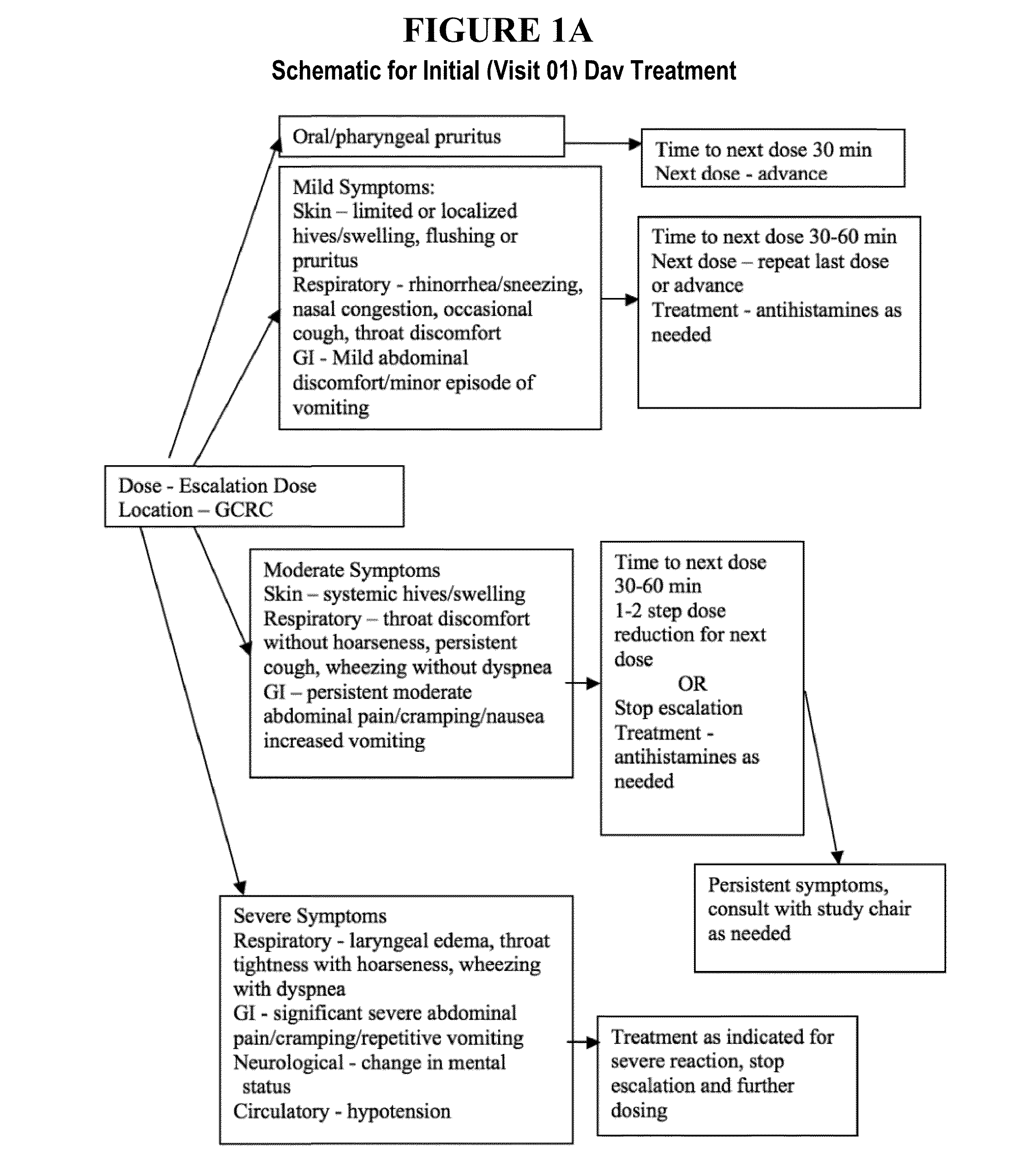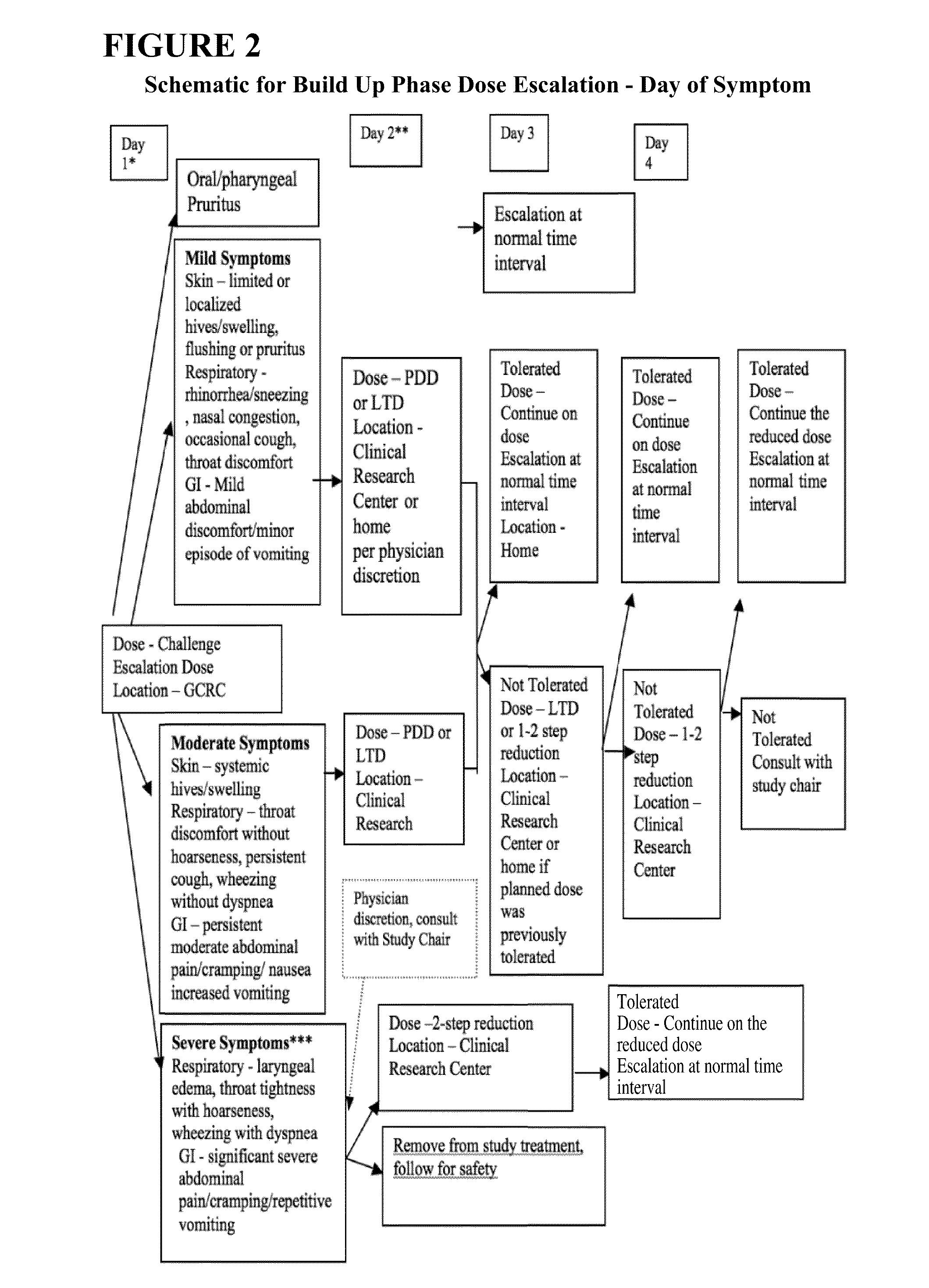Peanut formulations and uses thereof
a technology of peanuts and formulations, applied in the field of peanuts, can solve the problems of life-threatening, high levels of ige antibodies, and subjects with a high level of ige antibodies are known to be particularly prone to allergies
- Summary
- Abstract
- Description
- Claims
- Application Information
AI Technical Summary
Benefits of technology
Problems solved by technology
Method used
Image
Examples
example 1
Oral Desensitization to Peanut in Peanut-Allergic Children and Adults Using Characterized Peanut Allergen (CPNA) Oral Immunotherapy (OIT) [ARC 001]
[0226]
TitleOral Desensitization to Peanut in Peanut-Allergic Children andAdults using Characterized Peanut Allergen (CPNA) Peanut OralImmunotherapy (OIT)Short TitleCPNA Peanut OITNumber of Subjects50 peanut allergic subjects will be randomized 1:1 to peanut OITversus placebo.Study DesignThis is a multi-center, randomized, double-blind placebo-controlledstudy of efficacy and safety of characterized peanut OIT in peanutallergic individuals. All eligible subjects will receive an escalatingdose of characterized peanut allergen or placebo. At or around 6months, all eligible and enrolled subjects on active therapy willhave an extra 250 mg dose of peanut protein (measured as 500 mg offlour) administered to test for desensitization, and all eligible andenrolled placebo subjects will have a placebo challenge dose, tomaintain double-blinding. All s...
example 2
Oral Desensitization to Peanut in Peanut-Allergic Children and Adults Using Characterized Peanut Allergen (CPNA) Peanut Oral Immunotherapy (OIT) Safety Follow-Up Study [ARC 002]
[0534]
TitleOral Desensitization to Peanut in Peanut-Allergic Children andAdults using Characterized Peanut Allergen (CPNA) Peanut OralImmunotherapy (OIT) Safety Follow-Up StudyShort TitleCPNA Peanut OIT: Follow-UpClinical Phase2Study DesignThis is a multi-center, open-label follow-up study to gather additionalsafety information by continuing the 25 active therapy subjects fromARC001 for an additional 6 months of therapy with the ability toescalate to 2 gm of peanut protein and to cross over the 25 formerplacebo subjects to active treatment using the same dosing regimenused in ARC001Accrual ObjectiveUp to 50 peanut allergic subjects who completed ARC001 andconsent to enroll in ARC002 will be enrolledPrimary EndpointThe primary end-point is the safety of peanut OIT as measured by theincidence of serious adverse...
example 3
Exemplary Pharmaceutical-Grade Encapsulated Peanut Allergen and Use Thereof
[0800]Peanut flour used in the present compositions contains characterized peanut protein and is formulated with hydroxyl-methylcelluose and a flow agent in graduated doses, comprising capsules containing 0.1 mg, 1 mg, 10 mg, 100 mg and 475 mg each of peanut flour.
[0801]Oral immunotherapy in a food-allergic individual is accomplished by initially exposing the subject to the food allergen at doses below those associated with a clinical reaction, and subsequently increasing the dose in a step-wise fashion over a number of months (or longer). Clinical de-sensitization refers to the loss of clinical reaction to a limited amount of allergen in cases where lack of constant exposure to the allergen will result in re-established reactivity. Clinical tolerance, on the other hand, is not associated with renewed reactivity on loss of constant exposure. De-sensitization to a moderate amount of peanut protein (e.g., about...
PUM
| Property | Measurement | Unit |
|---|---|---|
| weight | aaaaa | aaaaa |
| weight | aaaaa | aaaaa |
| weight | aaaaa | aaaaa |
Abstract
Description
Claims
Application Information
 Login to View More
Login to View More - R&D
- Intellectual Property
- Life Sciences
- Materials
- Tech Scout
- Unparalleled Data Quality
- Higher Quality Content
- 60% Fewer Hallucinations
Browse by: Latest US Patents, China's latest patents, Technical Efficacy Thesaurus, Application Domain, Technology Topic, Popular Technical Reports.
© 2025 PatSnap. All rights reserved.Legal|Privacy policy|Modern Slavery Act Transparency Statement|Sitemap|About US| Contact US: help@patsnap.com



